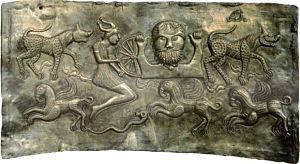Waterloo Helmet facts for kids
Quick facts for kids Waterloo Helmet |
|
|---|---|

On display in the British Museum
|
|
| Material | Bronze |
| Size | Height: 24.2 cm Circumference: 58.5 cm |
| Created | Iron Age, c.150–50 BC |
| Discovered | 1868 |
| Place | River Thames, London |
| Present location | Room 50, British Museum, London |
| Registration | 1988,1004.1 |
The Waterloo Helmet is a very special bronze helmet from ancient times. It was made by the Celts, a group of people who lived in Europe before the Romans. This helmet has cool horns and fancy designs. It was made around 150 to 50 BC, which is over 2,000 years ago!
It was found in 1868 in the River Thames in London, near Waterloo Bridge. Today, you can see this amazing helmet at the British Museum in London.
Contents
How the Helmet Was Found
This ancient helmet was pulled out of the River Thames in 1868. It was found near Waterloo Bridge in London. Soon after, in March 1868, it was loaned to the British Museum. Many years later, in 1988, the group that found it officially gave the helmet to the museum.
What the Helmet Looks Like
The main part of the helmet is made from two pieces of bronze. One piece forms the front, and the other forms the back. These pieces are joined together with small metal pins called rivets. A curved bronze piece is also attached to the front.
The helmet has two pointy bronze horns on top. These horns have round knobs at their ends. A decorative strip covers the joins where the bronze pieces meet. This strip also goes around the bottom of the horns. At the end of this strip, there are rings. These rings were likely used to attach a chin-strap or a piece to protect the cheeks.
There are also small holes around the bottom edge of the helmet. These holes might have been used to attach a soft lining inside the helmet.
Decorations on the Helmet
The helmet was decorated with six bronze studs. One of these studs is now missing. Three studs were on the front, and three were on the back. These studs have marks on them. These marks suggest they once held red glass decorations called enamel. Sadly, these colorful pieces are no longer there.
The helmet also has special designs on its front and back. These designs are made in a style called La Tène. This style was popular with the Celts. The patterns on the helmet are similar to those found on another famous ancient object, the Snettisham Great Torc.
Why Was This Helmet Made?
This helmet is made from thin bronze. This means it would have been too weak to use in a real battle. So, it was probably made for special ceremonies or parades. It's like how some ancient bronze shields were found. They also wouldn't have been strong enough for fighting. They were likely just for show.
Some experts think the helmet might be too small for most adult men. They suggest it could have been worn by a wooden statue of a Celtic god.
Many ancient objects like the Waterloo Helmet have been found in rivers. This includes other ceremonial bronze shields, such as the Battersea Shield and Witham Shield. People believe these items were thrown into the river as gifts to the gods. These gifts are called votive offerings.
Why the Waterloo Helmet is Important
The Waterloo Helmet is very rare. It is one of only three Iron Age helmets found in England. It is also the only horned helmet from the Iron Age found anywhere in Europe!
However, we do have pictures and carvings of people wearing horned helmets from other parts of Europe. For example, there are carvings of Gauls (another Celtic group) wearing horned helmets on a triumphal arch in France. These carvings are from around 55 BC. But these helmets look different from the Waterloo Helmet. The Waterloo Helmet has straight, cone-shaped horns. The helmets in the carvings have curved horns, like a bull's horns. They also have a wheel placed between the horns.
A similar image is found on the Gundestrup cauldron from Denmark. This cauldron shows a person wearing a horned helmet and holding a wheel. This helmet also has curved horns, but like the Waterloo Helmet, the horns have knobs at the ends instead of sharp points. Another ancient carving in France also shows people wearing horned helmets.
Even with these pictures, the Waterloo Helmet is still the only real horned helmet from this time period that we have found. Other Iron Age helmets found in Britain, like the Canterbury helmet, do not have horns.
Because the Waterloo Helmet is so unique, many modern drawings and movies show ancient British warriors wearing horned helmets. However, an archaeologist named Miranda Aldhouse-Green says this is "unfortunate." She explains that it gives a wrong idea of what most ancient British warriors actually wore.
Gallery of Reconstructions
See also



